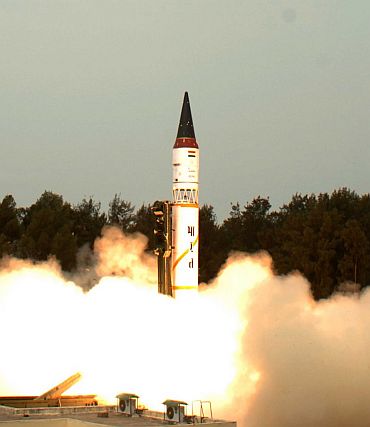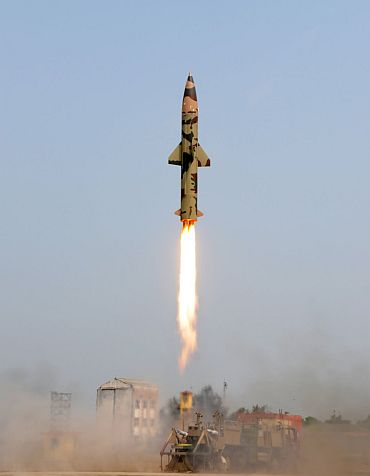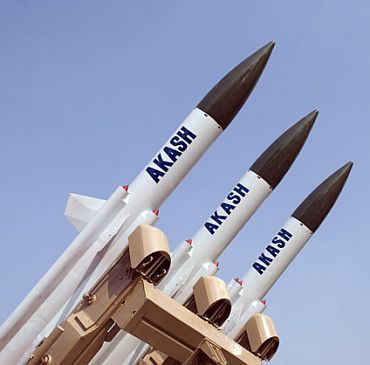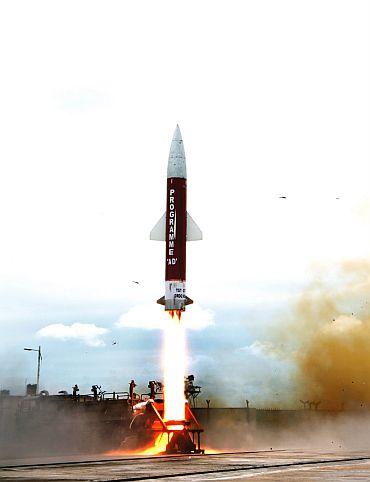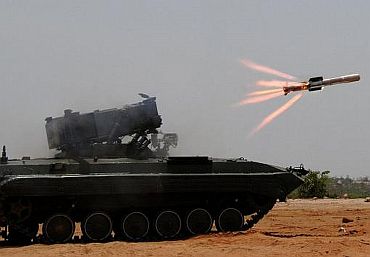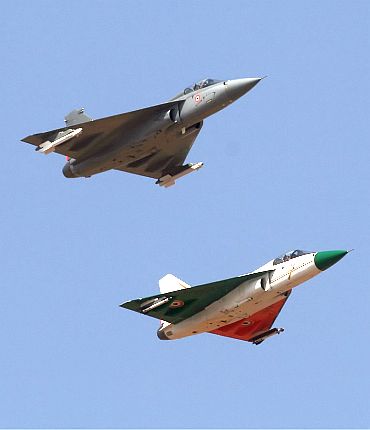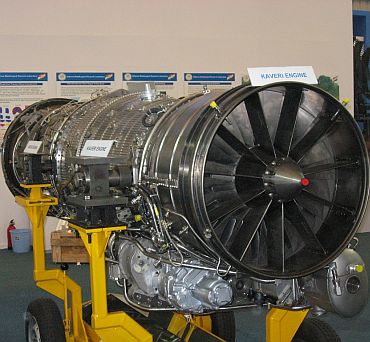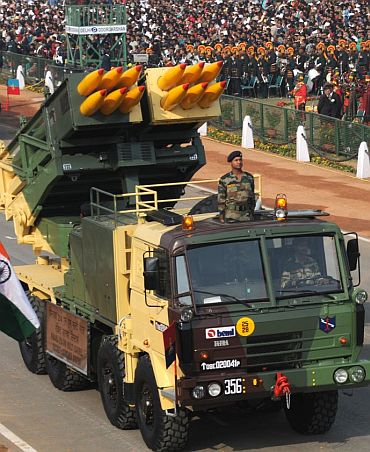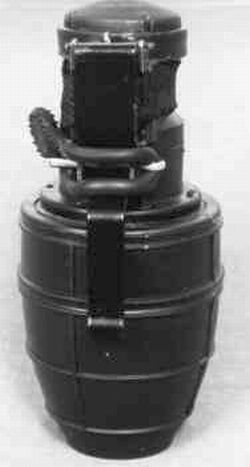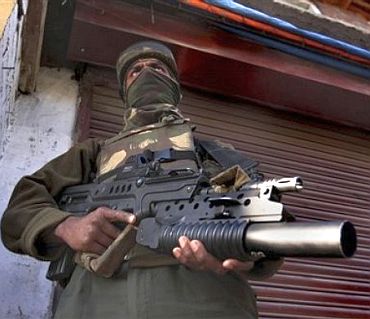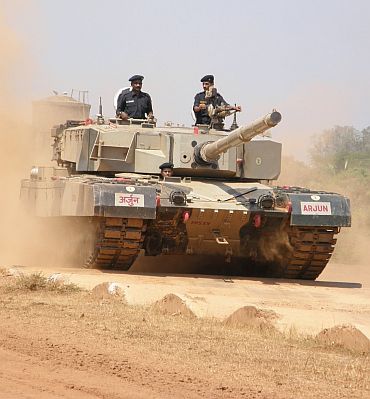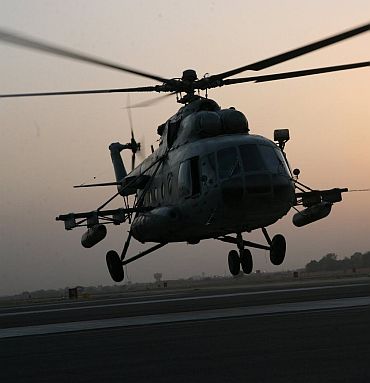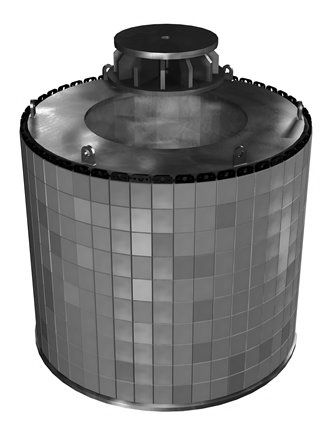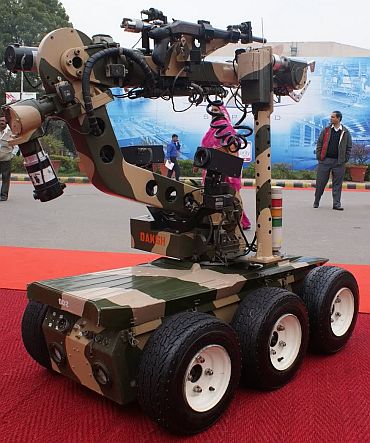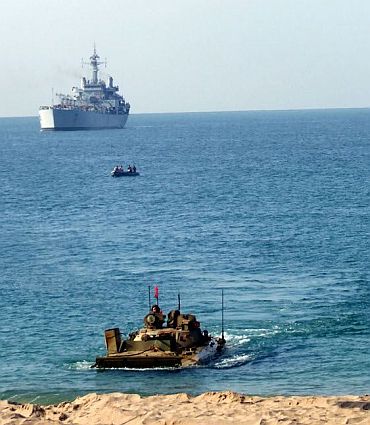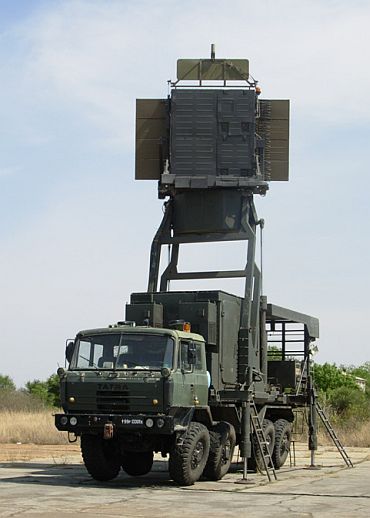 | « Back to article | Print this article |
DRDO's 20 most potent weapon systems
The production value of systems based on technologies developed by the DRDO (inducted/accepted/orders placed) during the past one decade is well over Rs 110,000 crore.
Let's take a look at some of the best technologies that DRDO has given India
Please click on NEXT to go further...
Agni missile
Agni-III is capable of carrying warheads weighing up to 1.5 tons, is 16 metres tall and weighs 48 tons.
Agni-I is a 750-800 km short-range missile. Agni-II has a range of more than 1,500 km. Both have already been inducted in the armed forces.
Agni-III is capable of reaching strategic targets deep inside China like Beijing and Shanghai. The 5,000 km-range Agni-V is a further advancement of the existing systems and is expected to be test-fired later this year.
Prithvi missile
Considered a world-class medium range missile, Prithvi, with a range of over 150 km has been inducted into the armed forces. The army had raised two specially trained missile groups, 333 and 355, to handle it.
The 8.56-metre-long missile is part of the Integrated Guided Missile Development Programme.
The Prithvi-I (150 km/1,000 kg) in army service, is capable of striking about a quarter of Pakistani territory, including Islamabad and most other major cities.Prithvi-II (250 km/500 kg), in air force service, could strike at least half of Pakistan, including almost all military targets of importance and all major cities.
Akash missile
Akash is a mobile area defence medium-range medium and high altitude surface-to-air missile with a range of 27 to 30 kilometres.
It is said to be indigenously developed, though it has a very strong resemblance to the Russian SA-6 GAINFUL. Akash has a multi-target handling capability, and employs a command guidance system with provision for terminal guidance. Powered by a ram rocket propulsion and an air breathing engine, Akash can cut through electronic jamming with its electronic counter measure equipment.
Akash has a launch weight of 720 kg, a diameter of 35 cm and a length of 5.8 metres. It can fly at supersonic speed of around 2.5 Mach and can reach an altitude of 18 kms. It has a capacity to carry 50 kg payload.Orders worth over Rs 25,000 crore for surface-to-air missile AKASH have been placed by the users. These include eight squadron for the IAF and two regiments for the army.
Endo-Atmospheric Interceptor
The DRDO has carried out successful flight tests of the missile defence system for 2,000 km class target were carried out.
Each flight led to a direct target hit and disintegration of the target.
The interceptor, designed for endo-atmospheric conditions (up to an altitude of 30 km) is a seven-metre-long and single stage solid rocket propelled guided missile, and is equipped with an inertial navigation system, a hi-tech computer and an electro-mechanical activator totally under command by the data uplinked from the sophisticated ground-based radars to the interceptor.
Nag Anti-Tank missile
Nag is a third- generation "fire and forget" anti-tank guided missile with a range of 4 to 6 kilometres. Nag can be mounted on an infantry combat vehicle and helicopter launched version of Nag is also available.
Nag is a third generation anti-tank missile system with "fire and forget" and "top attack" capabilities.
Capable of defeating modern armour, Nag uses Imaging Infra-Red guidance having both day and night capability.
The state-of-the-art Imaging Infra Red homing guidance system has lock-on-before-launch capability for day and night operation.
BrahMos cruise missile
The missile can fly at 2.8 times the speed of sound. It can carry warheads up to 200 kg in weight and has a maximum range of 290 km.
The missile is capable of being launched from multiple platforms based on land, sea, sub-sea and air. The modular design of the missile and its capability of being launched at different orientations enables it to be integrated with a wide spectrum of platforms like warships, submarines, different types of aircraft, mobile autonomous launchers and silos.
Thus, BrahMos block II with target discrimination precision strike capabilities has been test-fired. Similarly, BrahMos block III with capability for steep diving from high altitudes and high manoeuvres at multiple points during supersonic flight has also been test fired.
Light Combat Aircraft Tejas
In the area of Aeronautics, Tejas, the Light Combat Aircraft concluded its extensive flight tests including weapon trials, dropping of bombs, jettisoning drop tanks and night flights; leading to its Initial Operational Clearance on January 10, 2011.
The LCA is the smallest and lightest combat jet in the world.
Confusion may arise with respect to the South Korean T-50, but it must be remembered that T-50 is primarily a hybrid trainer, that can assume fighter roles when necessary. The T-50 has a higher height and longer wingspan than the LCA, while its length is shorter by 22 cm.
Over 1,640 flights covering a period of over 969 hours have been completed by Tejas Mark 01. The first prototype of LCA Navy was rolled out and its induction tests were concluded.
Unmanned Aerial Vehicles
Rustom-1: The Rustom 1 has a planned endurance of 12-15 hours, can carry payloads of up to 75kg and has a maximum ceiling of 25,000ft. The UAV's datalink was designed and developed by India's Defence Electronics Applications Laboratory, while its airframe and most of its electronics were produced by Indian companies.
Nishant: In a battlefield, Nishant can help army units to acquire targets to direct heavy artillery shelling and for guiding fighter aircraft to fire rockets and drop precision bombs at enemy positions and in an anti-tank role. Nishant, a remotely piloted vehicle (RPV) designed and developed by ADE, has an endurance of four to five hours and a range of 100 km in its primary roles. Flying at a speed of 40 to 60 metres per second, the UAV is capable of relaying data in real time to the army units moving forward in a battlefield condition.
Micro Aerial Vehicles: MAVs weigh only 300 grams and are 300 millimetres long. Since they are not entirely made of metal and carbon fibres, they are hard to intercept by radars and sensors. These MAVs have a range of two to five kilometres and they fly some 100 to 200 metres above the ground for 30-40 minutes and capture images
Sudarshan missile system and Kaveri engine
Sudarshan: The Sudarshan missile has been developed indigenously to occupy the niche of a precision delivery mechanism. It can neutralise any target in a 800-1,000 km range with a zero margin of error.
Sudarshan will use a laser of a specific frequency bandwidth to locate the target. The laser creates a heat signature on the target. The missile recognises the signature and homes in on it even if the target is moving
Kaveri: The Kaveri engine is a major milestone for the DRDO. The indigenous development of the fighter aircraft engine was achieved with the completion of its simulated operating conditions.
Advanced Light Helicopter MK-III
HAL's Dhruv Advanced Light Helicopter is a multi-role, multi-mission new generation helicopter in the 5.5 tone weight class. Its state-of-the-art technology provides for lightweight and yet rugged construction, superior automated fuel management system and excellent all weather day and night capability.
The Shakti-powered Dhruv Mark III is changing the operational dynamics on India's high-altitude Himalayan defences. The capability to airlift soldiers will allow far-flung posts to be manned with fewer soldiers. In a crisis, soldiers can be airlifted quickly from lower altitudes to threatened areas, and casualties can be evacuated.The MK-III sports a new electronic warfare suite, advanced laser warning systems, missile warning systems and electro-optical pods. It has a new-generation vibration-control system in place along with the glass cockpit. It also has an automatic chaff-and-flare dispenser
Pinaka Multi Barrel Rocket Launcher System
The indigenously built Pinaka multi-barrel rocket launcher Weapon Area System can fire rockets with a range of 39-40 km, in a salvo of 12 rockets with 1.2 tons of high explosives within 40 seconds
Pinaka can neutralise a target area of 350 square kilometres, and is meant as a supplement to the existing artillery system at a range beyond 30 km.It can be fitted with a variety of warheads ranging from blast-cum-pre-fragmented high explosives to anti-tank mines.
Development of the missile system was achieved with the successful transfer of technology to production agencies, two regiments of Pinaka (worth Rs 1300 crore) have been raised by army, which is likely to place orders for another two regiments.
Shivalik multi-mode grenade
Shivalik uses a modular plastic body and pre-formed cylindrical mild steel fragments for uniform distribution of fragments to overcome these deficiencies.
Additional features have been incorporated into the fuse's arming mechanism to ensure greater safety during storage, transportation and airdropping.
Unlike earlier grenades, it can be para-dropped if urgent re-supplies are needed and can function in temperatures ranging from minus 20 to 55 C
The use of plastic has also resulted in reduction of the grenade's overall weight.
UBGL and the chilli grenade
The 40 mm Under-Barrel Grenade Launcher is attached to rifles for increasing their firepower.
The UBGL, which can be mounted on the INSAS as well as AK-47 rifles, was developed keeping in view the global trend in technology for small arms from the concept of point-target capability to area-target capability.
Capable of night-firing, it fills the gap between the maximum range achieved by a hand grenade and the minimum range of a mortar while giving better accuracy than both.
Another unique weapon under development by the DRDO is the chill grenade, which uses extract of Bhut Jolokia, certified as the world's hottest chilli and is native to the northeast.
Part of a range of equipment being developed by the DRDO for counter-insurgency and internal security operations, the chilli-grenade is non-toxic and non-lethal and functions like tear-gas used by the security forces. Its pungent fumes can smoke out terrorists or hostile elements from hideouts.
Arjun Main Battle Tank
Conceived in 1973, the Arjun tank was behind schedule by more than 15 years, resulting in the Indian Army choosing the Russian T-90 tank as its main battle tank.
The Arjun had to go through a series of trials and retrials before the army announced the tank fit for duty.
MBT Arjun Mark I has been successfully inducted in the army and two regiments of Arjun MBT have been raised.
The Mark-II Arjun incorporates up to 90 per cent of indigenous content, compared with 58 per cent in the earlier model, and should be ready for induction by 2014.
The Mark-II also will feature superior missile-firing capabilities.
Light-weight composite armour
Lightweight Ceramic Faced Composite Armour Panels for Advanced Light Helicopter and Mi-17-IV helicopter have successfully undergone integration and flight-trials.
This provides protection to aircrews and critical parts of helicopter against hits of bullets of 12.7 mmAPI.
Composite laminates were made using kevlar fabric as reinforcement and modified epoxy resin for matrix.
Kevlar-epoxy composite laminates of different thicknesses were prepared by compression moulding process.
Kevlar-epoxy composite laminates were bonded with alumina ceramic cylindrical pellets with the help of epoxy structural adhesive. Gaps between the ceramic pellets were filled with modified epoxy resin.
Hull Mounted Sonar Advanced
Humsa is an enhanced version of the state-of-the-art Hull Mounted Panoramic Sonar designed for the Indian Navy in the nineties.
This family of medium range active-cum-passive dual band sonars, optimised for both shallow and deep-water operations has proved its efficacy even in the highly variable tropical waters for more than a decade. Humsa's advanced signal processing techniques are responsible for its superior performance.
Humsa-NG is a technology upgrade of Humsa with lower frequency transducers and state-of-the art electronics containing Power PC processors and SHARC signal processing boards.
The Humsa-NG was developed by the DRDO's Naval Physical and Oceanographic Laboratory for the Indian Navy's Project 15A/Kolkata-class destroyers.
Unmanned vehicles and robots
Autonomous Underwater Vehicle: The Autonomous Underwater Vehicle maps the sea bed and observe underwater movements. It is controlled by wireless navigational instruments from land.
The AUV-150 is used as a tool for coastal security operations. The device measures 4.8 metres in length and weighs 490 kg. This unmanned vehicle operates on battery.
Rov Daksh: Daksh is an electrically powered and remotely controlled robot used for locating, handling and destroying hazardous objects safely. Its primary role is to recover improvised explosive devices (IEDs).
It locates IEDs with an X-ray machine, picks them up with a gripper-arm and defuses them with a jet of water. It has a shotgun, which can break open locked doors, and it can scan cars for explosives. Daksh can also climb staircases, negotiate steep slopes, navigate narrow corridors and tow vehicles.
Mobile command centres
Carrier Command Post Tracked: The Carrier Command Post Tracked BMP-II has been designed to function as a self-propelled artillery command post.
It affords nuclear, biological and chemical protection and protection against small arms.
Armoured Amphibious Dozer: AAD is designed to provide integral engineering support to battle groups in offensive operations by reducing banks of water obstacles to facilitate construction of wet/dry assault bridges.
It also improves mobility of mechanised formations by construction and improvement of existing tracks. AAD is based on re-engineered BMP-II chassis.
Radar Technology
Rohini: The Multifunction Medium Range Surveillance Radar is capable of handling multiple targets simultaneously and also precisely calculate the height at which projectiles are flying.
Operating in a range of upto 170 kilometres and an altitude of 15 kilometres, the Rohini radar can track multiple targets like fighter jets and missiles travelling at supersonic speeds of over 3,000 kms per hour, viz around Mach 3. The radar employs an array of Electronic Counter Counter Measure (ECCM) features including frequency agility and jammer analysis
Aslesha and Bharani: The 3D low-level, light-weight radar is designed for use in mountainous terrain and against aerial targets
Samyukta: Samyukta is capable of handling both ground-based and airborne threats. It has the capability to intercept, detect, search, identify and locate complex communication and radar signals.
It monitors and analyses communication and radar activity across Forward Edge of the Battle Area (FEBA) and many other sophisticated features. Once deployed, the system has operational frontal coverage of 150/70 km.

